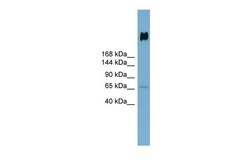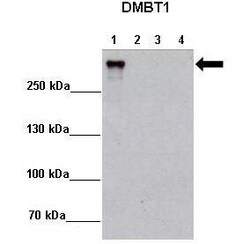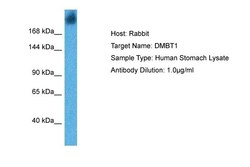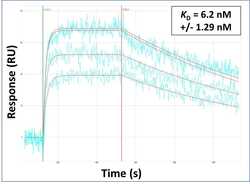PA5-107112
antibody from Invitrogen Antibodies
Targeting: DMBT1
Gp-340, GP340, hensin, muclin, SALSA, vomeroglandin
Antibody data
- Antibody Data
- Antigen structure
- References [0]
- Comments [0]
- Validations
- Western blot [3]
- Other assay [1]
Submit
Validation data
Reference
Comment
Report error
- Product number
- PA5-107112 - Provider product page

- Provider
- Invitrogen Antibodies
- Product name
- GP340 Polyclonal Antibody
- Antibody type
- Polyclonal
- Antigen
- Synthetic peptide
- Reactivity
- Human
- Host
- Rabbit
- Isotype
- IgG
- Vial size
- 100 μL
- Concentration
- 0.5 mg/mL
- Storage
- Store at 4°C short term. For long term storage, store at -20°C, avoiding freeze/thaw cycles.
No comments: Submit comment
Supportive validation
- Submitted by
- Invitrogen Antibodies (provider)
- Main image

- Experimental details
- Western Blot analysis of GP340 in human stomach using a GP340 Polyclonal Antibody (Product # PA5-107112) diluted to 0.2-1 µg/mL.
- Submitted by
- Invitrogen Antibodies (provider)
- Main image

- Experimental details
- Western Blot analysis of GP340 in human using a GP340 Polyclonal Antibody (Product # PA5-107112) diluted 1:5000. Lane 1: 2 µg MCF7-DMBT1+Dox. Lane 2: 2 µg MCF7-DMBT1 -Dox. Lane 3: 2 µg MCF7-Ctrl+Dox. Lane 4: 2 µg MCF7-DMBT1 -Dox. Secondary antibody diluted 1:10,000. Image courtesy of Matthias Rauen, Lundbeckfonden Center of Excellence NanoCAN, University of Southern Denmark.
- Submitted by
- Invitrogen Antibodies (provider)
- Main image

- Experimental details
- Western Blot analysis of GP340 in human stomach using a GP340 Polyclonal Antibody (Product # PA5-107112) diluted to 0.2-1 µg/mL.
Supportive validation
- Submitted by
- Invitrogen Antibodies (provider)
- Main image

- Experimental details
- Surface Plasmon Resonance of GP340 polyclonal antibody (Product # PA5-107112). Purified polyclonal antibodies were immobilized on a Protein A/G coated Carterra LSA sensor chip at concentrations of 5, and 50 µg/mL in duplicate. Antibodies on the surface were exposed to interaction with peptides sequentially via microfluidic controlled flow at 333 nm peptide concentration for kinetic characterization of the binders for affinity and specificity, followed by curve fitting using the Kinetics software. Kd determinations for both concentrations were averaged and results and standard deviation are shown.
 Explore
Explore Validate
Validate Learn
Learn Western blot
Western blot